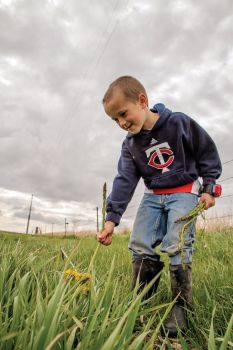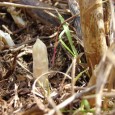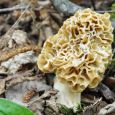The Gift of South Dakota
Subscriptions to South Dakota Magazine make great gifts!
Subscribe today — 1 year (6 issues) is just $29!
America's Asparagus Gap
May 6, 2013
"Where to find spring asparagus" reads the headline on the New York Magazine website. Hmmm, I'm thinking, we have a similar story in our May/June issue. Perhaps we're not so different from our fellow journalists in the Big Apple.
So I read the New York Magazine story and learn that the writer is simply suggesting how to find asparagus at six restaurants that I've never heard of, including Rosemary's, Rouge Tomate and Northern Spy Food Co., the latter of which is featuring a $27 plate of weakfish with a spring stew of fava beans, fiddleheads, asparagus, rice beans and nettle fume.
Sounds good enough, but very different from our story which suggests that you drive down a gravel road and search for wild asparagus in the ditches. It grows there because South Dakota once had more than 80,000 farms, and almost every farm had a garden. Many of the family farmsteads are gone, but the asparagus continues to spread. You just have to know where to look.
Our asparagus expert is Russ Olson, a friend from Madison who serves Lake and Moody counties in the state senate. Russ has been an asparagus hunter since his childhood days at Egan. He suggests that rookies look for last year's left-over growth. "The old plant will be two or three feet high and look like a spindly tumbleweed," he says. "Find that and you'll find new growth around it."
Russ says the asparagus stalks are ready for harvest about the time the lilacs bloom. "Snip the new shoots when they are about 10 inches high," he says. "And leave them alone after July 4th so they can recover for next year."
That's our idea of an asparagus hunt. But don't misunderstand me. I'm not knocking the New York variety. Avoiding comparisons with other states has long been one of our principal editorial goals at South Dakota Magazine. Geographic comparisons almost always devolve into snobbery, intentionally or not. I suspect that many rural Americans of both political parties cringed when Sarah Palin suggested that her rural upbringing qualified her for high political office. "We grow good people in our small towns, with honesty, sincerity and dignity," she said. "They are the ones who do some of the hardest work in America, who grow our food run our factories and fight our wars. They love their country in good times and bad, and they are always proud of America."
And our city friends are not hard-working, patriotic and proud?
Eighty percent of Americans have voted on this with their feet. They live in urban and suburban communities. The vast majority of our small towns, including almost every one in South Dakota, is struggling to attract young people. Not to pick on Sarah (because she's hardly the first small-state politician or writer to romanticize the virtues of Green Acres living), but we think it's important for rural America to avoid the practice of rural reverse snobbery. The we're-better-than-everyone-else-ism seems to be one thing that many young people dislike about their small towns.
So we say enjoy the asparagus wherever you live — whether it be Brooklyn or Brookings or Batesland. But $27 a plate? If the price gets any higher, surely our city cousins will be cruising the dirt roads of Moody County, looking for the wild variety.











Comments
I'm willing to contribute a great big dandelion green salad and nettle fume...once i figure out what fume means.
I am comforted to read that I wasn't the only one failing to recognize ''nettle fume''. Nettles get overlooked as wild food.Probably because they will sting.They are recognized as very nutritious and I'm familiar with nettles in soup, pesto and ravioli.
Lately kitchen gadgets have recently created a ''smoking'' fad. Just guessing but I reckon more sophisticated folks refer to smoked nettles as nettle fume'.